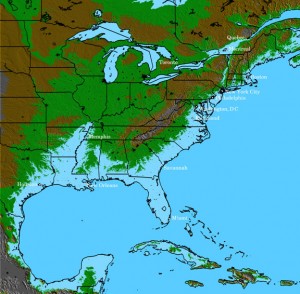While coalitions meeting at Copenhagen this December may have many different needs, perspectives, and individual goals, it is important to remember the interconnectivity of the Earth.
Interconnectivity: The concept that all parts of a system interact with and rely on one another simply by the fact that they occupy the same system, and that a system is difficult or sometimes impossible to analyze through its individual parts considered alone.
As a biologist will tell you, dividing the Earth into ecosystems is misleading. While it may be possible to draw distinctions between different environments on Earth, exactly where the lines are drawn is arbitrary.
And every system affects one another. New York City and the Adirondacks are not mutually exclusive although it may seem as if you have to drive through a lot of rural area to get to the mountains. While Romantic Natural History (Blake, Wordsworth, Thoreau, Emerson, etc.) required a view of humanity as separate from nature, “we have ended the thing that has, at least in modern times, defined nature for us – its separation from human society (McKibben, 55). Man cannot consider himself separated from nature if his actions are changing its most fundamental aspects – “the wind, the sun, the rain” (41). McKibben argues that by changing these aspects, the meaning of nature has already changed (41). “Yes, the wind still blows – but no longer from some other sphere, some inhuman place” (41).
Our actions are so large that:
Man controls nature.
And every action is connected to one another. The largest threat to a constant, unchanging nature has been a misunderstanding: the smog in our cities doesn’t affect our pristine landscapes. Yes, as a matter of fact, it does.
But now that we’ve recognized our interconnectivity, how can we divide our answers into coalitions?
Don’t get me wrong, colations are necessary. Coalitions offer a streamlined version of country or area-specific problems and offer solutions. Let’s just remember:
One coalition’s solutions affect everyone.
Each piece to the puzzle cannot be considered individually, but through its far-reaching effects. By the definition of interconnectivity, the individual parts cannot be examined without analyzing the entire system.
So it’s very important to work as a team. We cannot solve drought, desertification, and floods in Africa without having some affects elsewhere. What are these affects? It’s our duty to predict them before choosing solutions so we can make educated decisions that are globally beneficial.
And there is the key word: global.
It’s called global warming for a reason. It’s a global problem with global solutions. The definition itself should remind us of just how interconnected we all are.
Remember, there’s no “i” in global warming.
(Hence why I haven’t mentioned climate change.)
Works Cited:
McKibben, Bill. The End of Nature. New York: Random House Trade Paperbacks, 2006.
Bill McKibben (from National Geographic)
ead all articles by Brett Shollenberger on this blog!
Read articles by Brett Shollenberger in Dickinson Magazine!
Read Brett Shollenberger‘s blog!
Tags: Brett Shollenberger, climate change, coalitions, COP15 Resources, interconnectivity
We could talk about climate change for years.
No, seriously. If every country in the world spoke their piece individually at the UN conference in Copenhagen this year, there is no way the issues at hand could be resolved in a two-week period. Recognizing this, the UN has organized itself into groups or coalitions of nations and states from around the world, therefore decreasing the number of speakers per conference and allowing for more cooperative work to take place in between world-wide meetings.
One such group is the Alliance of Small Island States (AOSIS), a coalition of island and low-lying coastal nations whose primary objective is to gain political power by unification. Alone, their small voices would likely go unheard. Established in 1990, the group has no formal constitution, but is driven by clear, common political objectives, including:
– Polluter pays
– Environmental conservation
– Renewable energy
– Common but differentiated responsibilities
Although these nations are spread all over the world, they share a grim and binding common denominator: many of them are in danger of disappearing completely should sea level rise as much as predicted. The Intergovernmental Panel on Climate Change (IPCC) estimate that by 2100, sea level will rise 11-77cm. However in the past decade, sea level rise has exceeded that estimate , leading some scientists to suggest that the water may rise over a meter before the end of the century. For these low-lying states and nations, the effects would be devastating. Although sea level rise will threaten the coasts of all nations, these countries may be left without even enough land to stand on.
Since these states are the most vulnerable to drastic, immediate effects, uniting on the political stage gives them a powerful position in climate change negotiations. However, although they share common fears, the members come from all over the world and span a huge range of wealth and development, from wealthy states like Singapore and Cyprus to poor, under-developed islands like Samoa and Vanuatu. These differences make coordinating a plan of action between the members difficult, considering the huge variation in money, technology, and organization available to each country. For instance, Singapore, which lies less than 200 ft above sea level, announced strategies in 2008 to reduce energy consumption through technological advances, while Samoa, whose coast sits within 300 ft of the Pacific, will be seeking assistance from more developed countries through technology transfer legislation.
These changes are huge, and they are coming fast. Alone, these little countries might get lost in the shadow of bigger and more powerful nations, but together, they are a glaring, concrete reminder of how urgent the negotiations at Copenhagen this winter will be. Instead of fighting for the lives of distant descendants, we are fighting for the people across the table. They are the first ones to save.
While reading the CRS Report for Congress Global Climate Change: Three Policy Perspectives I came across something that was somewhat intriguing to me. Here is an excerpt:
“It is not necessary for consumers to change their behavior significantly to adjust to the “new reality” of an environmental problem.
What this is basically stating is that basically it will take little effort for the consumer to adapt to a greener product line. HOWEVER, I was taken aback by this. While a consumer has no problem adapting to say more energy efficient lightbulbs or a arsenic free Macbook Pro, they will not necessarily do so.

The "green" Macbook Pros.
However, companies need to make these things affordable and unfortunately they do not. The way it is projected to me as a consumer is that because big business is taking steps to make things greener it is your responsibility to cover those changes we had to make to our product line.
Primary example: while shopping for a dish sponge at Wal-Mart I had the choice of choosing a two-pack sponge for .99 or a sponge made from bamboo for 9.99. It was admirable for the company to offer an alternative, but it is not feasible at such a high price.
Another prime example, the Macbook Pros above. While Apple was able to turn their Pro computer line to a highly recyclable product with a small footprint it comes at a premium (as a user of one of these it is hard for me to criticize). Without sounding like one of those Laptop Hunter Microsoft ads you can get a computer that is equivalent for half the cost. So instead of sending 3,000.00 for a computer that will leave a smaller footprint, most consumers will look for the same speced laptop (sans operating system) for 2/3 the cost.
So the lens that consumers are looking for are affordability. Consumers don’t necessarily have to look hard to find “green” products–it is the “it” campaign to be involved with at the moment(sorry for the Bruno reference). But at the same time the consumer needs to be educated what “being green” actually is. We are exposed to tons of adverts from Madison Ave. talking about being green and what companies are doing to make their footprint smaller but most of us are looking at it through a translucent lens. Within those ads, advertising firms or PSAs need to be more efficient when talking about for example making the switch to CF bulbs.
While being green is sensible and of course is a good thing paying a high premium puts extra financial strain on families.
What should happen? Companies should lower prices–obviously easier said then done. If something is reusable–a company has to supplement the price of say a sponge or a lightbulb because consumers won’t be buying that often. It is a conundrum but as the sustainability catches on perhaps we will see a decrease in production costs.
Now I leave you with a “green” ad from Apple…
In the past the US has been acting like a spoiled child let loose in a candy store.
 The Bush administrations and the Clinton administration have not nurtured green technological energy alternatives sufficiently. Instead these administrations have acted like parents who periodically mention vegetables are good for you, but take you to the candy store every day.
The Bush administrations and the Clinton administration have not nurtured green technological energy alternatives sufficiently. Instead these administrations have acted like parents who periodically mention vegetables are good for you, but take you to the candy store every day.
The anarchy amongst states and lack of a more forceful parental influence from the United Nations on the international stage has caused many states like the US to horde oil without investing in greener fuels. The United States along with the rest of the world is realizing that they need a more diverse diet of energy resources that are renewable and have fewer environmental side effects. However, the United States solutions to these ‘candy shortages’ and ‘tummy aches’ have been shortsighted.
fuels. The United States along with the rest of the world is realizing that they need a more diverse diet of energy resources that are renewable and have fewer environmental side effects. However, the United States solutions to these ‘candy shortages’ and ‘tummy aches’ have been shortsighted.
Make candy healthy?
The US has often viewed climate change through a technological lens, which the Parker-Blodgett CRS Report for Congress describes as a belief that reducing green house gas emissions can be done by replacing inappropriate and misused technologies (the cause of the problem). It is true technological advances have been especially important for reducing emissions through advances in efficiencies of appliances (as was suggested in the Great Man Theory and TechnEgologic blogs) and industrial equipment. However, we cannot rely on large scale technological advances to rescue civilization from the consequences of the buildup of copious quantities of green house gases in the atmosphere, because these changes have already set into motion world-wide climactic and ecological shifts. It is too great a risk to rely on technological breakthroughs to come to the rescue when there is no certainty that they will be able to effectively counteract green house gas emissions. Physical or financial limitations need to be accounted for. Often technological solutions can also have unknown ecological consequences, as was the case with ocean iron fertilization experiments. This technological ‘solution’ has limited application due to biological limitations at a large scale as well as ecological side effects like deep water anoxia and potentially causing harmful red tides
Can you bribe a kid to eat veggies?
The US also views climate change through an economic lens. Parker-Blodgett suggest that it is a view that the problem of excess green house gas emissions is caused by improperly managed market signals and the solution to the problem is correcting market signals to incentivize reductions in green house gas emissions. Internalizing environmental externalities can be done through two main ways. One is through a cap and trade systems, which has been used in US energy markets with sulfur dioxide. However, having the government set emissions limit does not necessarily prevent excess pollution. Just like if you ration out candies for kids in a candy store you need to keep a close watch otherwise kids will take more if they think you are not looking. Another tactic is applying a carbon tax, which has been adopted in Europe. This has the potential to provide the right economic market signals if the tax level is neither too weak nor economically debilitating. The European Union has started using a carbon tax, which will hopefully encourage the US to follow suit. Considering the veracious sweet tooth of the US, the potential success is limited if you charge high prices for candy, but don’t grow vegetables.
Candy is no substitute for green veggies.
As Oliver Tickell arg ues in Kyoto2: How to Manage the Global Greenhouse, historical green house gas levels have already committed humanity to adapt to a world with warmer and more violent climate. Even adopting the best technological and economic solutions need to be supplemented by more systematic changes.
ues in Kyoto2: How to Manage the Global Greenhouse, historical green house gas levels have already committed humanity to adapt to a world with warmer and more violent climate. Even adopting the best technological and economic solutions need to be supplemented by more systematic changes.
This calls for a paradigm shift regarding US international policy that combines technological, economic, and ecological lenses in order to effectively assuage cooperative international action on climate change. The ecological lens is defined by Parker-Blodgett as disregard for nature, where change requires: people to act respectfully through their consumer choices, environmentally friendly businesses to receive financial support, and environmental regulations. Children need to learn veggies would taste as sweet as candy if they can look beyond a moment’s sugar craving. The US needs systematic changes in many areas of society such as adopting a mass transit system (like Europe’s), public commitment to lifestyle changes, etc. Ultimately, the Obama administration needs to take a more active role in climate change discussions in Kyoto 2. The US perspective needs to diversify the range of lenses it uses to view climate change. Ultimately, to assuage change in the US, consumer and business decisions need to take into account environmental damage caused by extraction, production, usage, and disposal of societal and consumer products by internalizing these externalities within the costs, which is described in The Story of Stuff.
Tags: climate change, ecological lens, fossil fuel addiction, paradigm shift, Philip Rothrock, US Energy Policy
The lens through which I see climate change solutions is somewhat of a hybrid of Parker & Blodgett’s three. Although I see the situation largely through the ecological lens, I feel that the other two lenses represent the flaws in our appreciation of the environment. All three lenses provide integral parts of the ultimate comprehensive solution, a solution which needs to be employed now. However, there are institutional and societal barriers to the change that needs to take place.
First, our society lacks a comprehensive environmental ethic which is in large part responsible for the environmental degradation that has for so long been permitted to take place. Our modern society has removed people so far from nature, many people don’t know the wonders of the environment because they are stuck in the city and have never gone on a nature hike or been in the woods. Because people are distanced from nature, the meaning of nature starts to diminish. Although it seems strange to me, governments legislate a type of environmental ethic. Since our society has deviated so far from a healthy relationship with the Earth, however, legislation and education is one of our last options.
In my opinion, the technological and economic lenses would not be necessary if there were a solidly established environmental ethic in capitalist culture. The fact that goods are not appropriately priced to encompass environmental damage is not a problem in itself: it is intrinsically linked to society’s disinterest in the environment. If there were a concern about the environment, goods would have been appropriately priced to reflect the environmental damage they caused. Technologies would not be invented if they were harmful to the environment, if the builders were concerned with the health of the environment or they would have been immediately corrected. Our lack of ethical concern with polluting the environment has now translated into this global problem.
Like the book Breakthrough states, it is important to develop new ideas and solutions because climate change is a new problem. It encourages the reader to think outside of the box because every-day, already existing technologies and methods may not work when confronting a problem as global as our warming environment.

Breakthrough Institute website: http://www.thebreakthrough.org


Your Comments